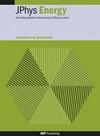High-temperature reduction thermochemistry of SrVO3-δ
IF 6.3
3区 材料科学
Q1 ENERGY & FUELS
引用次数: 0
Abstract
Abstract The cubic SrVO 3 perovskite oxide is an attractive candidate for high-temperature energy applications due to its favourable features, such as multiple oxidation states cations, high structural and thermal stabilities, ability to accommodate large number of oxygen vacancies, and cost-effectiveness. Herein, the temperature dependent reduction properties of SrVO 3 have been studied in terms of oxygen vacancy concentrations using accurate first-principles calculations to reveal the effects of oxygen vacancy and temperature in the reduction aptitudes of SrVO 3-δ , δ = 0−0.125. The reduction capability of SrVO 3-δ was found to be significantly impacted by increasing oxygen vacancy concentrations and temperatures. Analyses of electronic properties and vibrational properties of SrVO 3-δ in terms of δ revealed the origin of this reduction behavior. The electronic structure analysis showed that the reduction of SrVO 3-δ upon oxygen vacancy formation is highly localized to the neighboring V 4+ t 2g states at the vicinity of the oxygen defect, irrespective of δ. A comparison of the vibrational density of states of the defect-free and defective SrVO 3-δ demonstrated that the ionic contributions to the phonon density of states, and hence to the thermal contributions into the SrVO 3-δ lattices, were significantly disrupted by the introduction of oxygen vacancies, which ultimately impacted to the temperature dependent reduction behavior of SrVO 3-δ .
SrVO3-δ的高温还原热化学
立方srvo3钙钛矿氧化物具有多种氧化态阳离子、高结构和热稳定性、能够容纳大量氧空位以及成本效益等优点,是高温能源应用的一个有吸引力的候选者。本文采用精确的第一性原理计算方法,从氧空位浓度的角度研究了srvo3的温度依赖性还原性质,揭示了氧空位和温度对srvo3 -δ (δ = 0−0.125)还原能力的影响。SrVO 3-δ的还原能力受到氧空位浓度和温度的显著影响。对SrVO 3-δ的电子性质和振动性质进行了δ分析,揭示了这种还原行为的原因。电子结构分析表明,SrVO 3-δ在氧空位形成时的还原高度局限于氧缺陷附近的V 4+ t 2g态,与δ无关。对无缺陷和有缺陷的SrVO 3-δ的态振动密度的比较表明,离子对态声子密度的贡献以及对SrVO 3-δ晶格的热贡献被氧空位的引入显著破坏,这最终影响了SrVO 3-δ的温度依赖还原行为。
本文章由计算机程序翻译,如有差异,请以英文原文为准。
求助全文
约1分钟内获得全文
求助全文
来源期刊

Journal of Physics-Energy
Multiple-
CiteScore
10.90
自引率
1.40%
发文量
58
期刊介绍:
The Journal of Physics-Energy is an interdisciplinary and fully open-access publication dedicated to setting the agenda for the identification and dissemination of the most exciting and significant advancements in all realms of energy-related research. Committed to the principles of open science, JPhys Energy is designed to maximize the exchange of knowledge between both established and emerging communities, thereby fostering a collaborative and inclusive environment for the advancement of energy research.
 求助内容:
求助内容: 应助结果提醒方式:
应助结果提醒方式:


